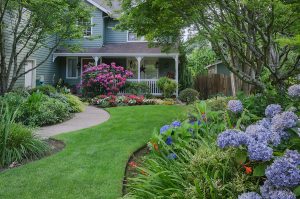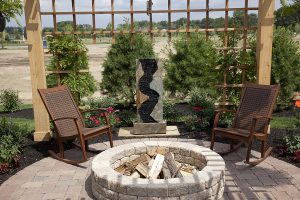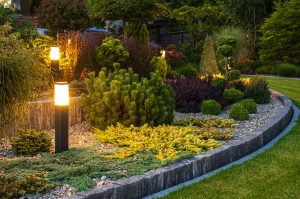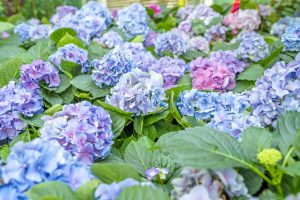
Edible landscaping is a growing trend in Massachusetts, where homeowners are looking to make the most of their outdoor spaces. By integrating edible plants into your landscape, you can enjoy fresh fruits, vegetables, and herbs while also creating a yard that is attractive year-round. When designed thoughtfully, edible landscapes fit seamlessly into New England properties and add beauty, practicality, and sustainability. In this blog, we’ll cover the best practices for integrating edible plants into your Massachusetts landscape and the varieties that thrive in our climate.
Continue reading Integrating Edible Plants into Your Landscape
 When those harsh New England winters roll in, will your backyard be ready? The work you put into it now not only means an easier management of your yard in the spring, but healthier plants with less ice and snow damage and less wear on your hardscape. Today, we’ll go over the essential tasks you should take preparing your backyard for winter before the first frost hits your neighborhood. Continue reading Preparing Your Backyard for Winter
When those harsh New England winters roll in, will your backyard be ready? The work you put into it now not only means an easier management of your yard in the spring, but healthier plants with less ice and snow damage and less wear on your hardscape. Today, we’ll go over the essential tasks you should take preparing your backyard for winter before the first frost hits your neighborhood. Continue reading Preparing Your Backyard for Winter
 When those harsh New England winters roll in, will your backyard be ready? The work you put into it now not only means an easier management of your yard in the spring, but healthier plants with less ice and snow damage and less wear on your hardscape. Today, we’ll go over the essential tasks you should take preparing your backyard for winter before the first frost hits your neighborhood. Continue reading Preparing Your Backyard for Winter
When those harsh New England winters roll in, will your backyard be ready? The work you put into it now not only means an easier management of your yard in the spring, but healthier plants with less ice and snow damage and less wear on your hardscape. Today, we’ll go over the essential tasks you should take preparing your backyard for winter before the first frost hits your neighborhood. Continue reading Preparing Your Backyard for Winter
 Edible landscaping is a growing trend in Massachusetts, where homeowners are looking to make the most of their outdoor spaces. By integrating edible plants into your landscape, you can enjoy fresh fruits, vegetables, and herbs while also creating a yard that is attractive year-round. When designed thoughtfully, edible landscapes fit seamlessly into New England properties and add beauty, practicality, and sustainability. In this blog, we’ll cover the best practices for integrating edible plants into your Massachusetts landscape and the varieties that thrive in our climate.
Edible landscaping is a growing trend in Massachusetts, where homeowners are looking to make the most of their outdoor spaces. By integrating edible plants into your landscape, you can enjoy fresh fruits, vegetables, and herbs while also creating a yard that is attractive year-round. When designed thoughtfully, edible landscapes fit seamlessly into New England properties and add beauty, practicality, and sustainability. In this blog, we’ll cover the best practices for integrating edible plants into your Massachusetts landscape and the varieties that thrive in our climate.  Creating a seamless indoor-outdoor transition is one of the most effective ways to extend your living space and improve how you use your home year-round. With strategic landscape design, you can connect indoor and outdoor spaces in a way that enhances comfort, flow, and overall property value. In this blog, we’ll explore expert-level strategies to help you bridge the gap between your home and your landscape.
Creating a seamless indoor-outdoor transition is one of the most effective ways to extend your living space and improve how you use your home year-round. With strategic landscape design, you can connect indoor and outdoor spaces in a way that enhances comfort, flow, and overall property value. In this blog, we’ll explore expert-level strategies to help you bridge the gap between your home and your landscape.  A well-designed garden isn’t limited by size. Even in urban environments, small outdoor spaces—balconies, patios, and courtyards—can be transformed into functional, inviting green spaces. With thoughtful planning, the right plant selections, and efficient design techniques, even the most compact areas can become a peaceful retreat or a vibrant extension of your home. In this blog, we’ll go over how you can maximize your outdoor space to create a welcoming atmosphere.
A well-designed garden isn’t limited by size. Even in urban environments, small outdoor spaces—balconies, patios, and courtyards—can be transformed into functional, inviting green spaces. With thoughtful planning, the right plant selections, and efficient design techniques, even the most compact areas can become a peaceful retreat or a vibrant extension of your home. In this blog, we’ll go over how you can maximize your outdoor space to create a welcoming atmosphere.  Have you ever noticed how a single weed can take over your garden if left unnoticed? That same principle applies to your landscape—what starts as a minor issue can quickly escalate into an inconvenient problem, requiring lots of maintenance. Regular landscape inspections can help you catch problems early, ensuring your landscape stays beautiful and healthy all year round. In this blog, we’ll go over why regular landscape inspections are crucial and how they can help your landscape flourish.
Have you ever noticed how a single weed can take over your garden if left unnoticed? That same principle applies to your landscape—what starts as a minor issue can quickly escalate into an inconvenient problem, requiring lots of maintenance. Regular landscape inspections can help you catch problems early, ensuring your landscape stays beautiful and healthy all year round. In this blog, we’ll go over why regular landscape inspections are crucial and how they can help your landscape flourish.  When it comes to creating a beautiful yard, most of us picture spending our hot summer days mowing the lawn and pulling endless piles of weeds. But what if there was a way to enjoy a gorgeous outdoor space without the constant upkeep? The solution may be simpler than you think: hardscaping. By incorporating stonework features like walkways, patios, retaining walls and more, you can eliminate constant upkeep and turn your yard into a hassle-free retreat. In this blog, we’ll dive into the best low-maintenance hardscaping elements that will make your yard look amazing—without the hassle.
When it comes to creating a beautiful yard, most of us picture spending our hot summer days mowing the lawn and pulling endless piles of weeds. But what if there was a way to enjoy a gorgeous outdoor space without the constant upkeep? The solution may be simpler than you think: hardscaping. By incorporating stonework features like walkways, patios, retaining walls and more, you can eliminate constant upkeep and turn your yard into a hassle-free retreat. In this blog, we’ll dive into the best low-maintenance hardscaping elements that will make your yard look amazing—without the hassle.  A well-kept garden enhances a home’s curb appeal. When the mowing, trimming, and pruning stops, grass and plants can grow uncontrollably. The result? An eye-sore that can be as dangerous as it is unappealing. The reasons for an overgrown garden space can vary, but the good news is that your outdoor space is not entirely hopeless. In this blog, we will discuss how to rescue an overgrown garden and the steps you can take to keep history from repeating itself.
A well-kept garden enhances a home’s curb appeal. When the mowing, trimming, and pruning stops, grass and plants can grow uncontrollably. The result? An eye-sore that can be as dangerous as it is unappealing. The reasons for an overgrown garden space can vary, but the good news is that your outdoor space is not entirely hopeless. In this blog, we will discuss how to rescue an overgrown garden and the steps you can take to keep history from repeating itself. The grass is blanketed in snow. The trees are leafless. And the ponds are frozen over. But this year, Punxsutawney Phil didn’t see his shadow, thereby predicting an early spring! And if this famous groundhog is right, it means now’s the perfect time for New England property owners to engage in thoughtful planning for the upcoming season. Here are nine things you can do now during these final weeks of winter to prepare your landscape for spring.
The grass is blanketed in snow. The trees are leafless. And the ponds are frozen over. But this year, Punxsutawney Phil didn’t see his shadow, thereby predicting an early spring! And if this famous groundhog is right, it means now’s the perfect time for New England property owners to engage in thoughtful planning for the upcoming season. Here are nine things you can do now during these final weeks of winter to prepare your landscape for spring. As daylight saving time comes to an end here in New England, it’s only going to get darker outside. So, we figure now’s a great time to talk about landscape lighting options—whether you’re looking to illuminate your property or increase your home’s safety and security. From spotlights that accentuate architectural features to gentle path lights guiding your way, the choices seem endless. However, finding the perfect lighting for your home’s landscape and hardscape is easier when you consider your specific outdoor spaces and needs. Let’s explore.
As daylight saving time comes to an end here in New England, it’s only going to get darker outside. So, we figure now’s a great time to talk about landscape lighting options—whether you’re looking to illuminate your property or increase your home’s safety and security. From spotlights that accentuate architectural features to gentle path lights guiding your way, the choices seem endless. However, finding the perfect lighting for your home’s landscape and hardscape is easier when you consider your specific outdoor spaces and needs. Let’s explore. Spring is just around the corner; before we know it, all the snow will be melted, and it’ll be time to start tending to the gardens. Take a look around your yard: what are you growing this year? When you head to the nursery, your plant purchasing options come down to two primary categories: annuals or perennials. Today, we’re going to share the things
Spring is just around the corner; before we know it, all the snow will be melted, and it’ll be time to start tending to the gardens. Take a look around your yard: what are you growing this year? When you head to the nursery, your plant purchasing options come down to two primary categories: annuals or perennials. Today, we’re going to share the things